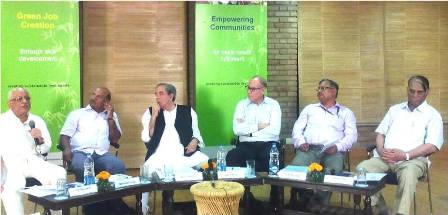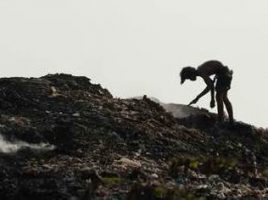Food Security: The Big Question of Resources
The ninth discussion in the series of trialogue 2047, explored the nexus between Water-Energy-Food in understanding food security. Six eminent speakers from the areas of agriculture, systems, and resource studies joined us for this trialogue 2047. The key speakers were Dr Ashok Khosla, Chairman, Development Alternatives; Dr Biksham Gujja, Chairman, AgSri Agricultural Services Pvt. Ltd; Dr David Dror, Chairman, Micro Insurance Academy; Mr J.M. Mauskar, Advisor, Observer Research Foundation; Dr S.R. Hashim, Chairman, Indian Association of Social Science Institution and Dr S.P. Sharma, Ministry of Water Resources.
Agriculture, the soul of food security, is a highly resource-intensive sector. It accounts for 70% of global freshwater withdrawals and 30% of global energy consumption (FAO, 2011). However, increasing population and socio-economic development needs threaten the availability of and access to key resources for food production.
On being asked to comment on the policy interventions needed to address resource conflicts, the discussants argued that the subsidisation of fuel and electricity for farmers has done more harm than good. We are no longer in an era of free and abundant energy and water, but due to cheap availability of these resources, farmers prioritise resource-intensive crops such as wheat and rice. Dr Sharma highlighted the fact that many farmers in Vidarbha, a fairly dry region, are growing rice, an extremely water-intensive crop. In fact, Dr Hashim pointed out that India exports a considerable amount of water in the form of rice. Incentives should be provided to help farmers shift from singularly producing resource-intensive crops to producing a variety of crops.The discussants also unanimously agreed that food grain wastage in India is unacceptably high. A quick scan of the literature indicates that between 30 to 40% of foodgrains produced are wasted each year (The New Indian Express, 2013).The government must invest in infrastructure to ensure safe storage, and limit damage and loss during transit.
On the subject of technology solutions for attaining optimum utilisation of resources, Dr Gujja also indicated that technologies which produce more with less and simultaneously not compromise livelihood security; are readily available and have good potential for profits to the farmers. For instance, the Sustainable Sugarcane Initiative (SSI) and System of Rice Intensification (SRI) have both successfully demonstrated their potential to increase yields per acre by 10 percent. However, a very small percentage of people are willing to invest in agriculture, making not the lack of technology, but the lack of investment and imagination- the real problem.
The discussants agreed in general that there is an incoherence of macro policies with local needs. Dr Dror painted a rather bleak picture when he spoke about how despite the legal abolishment of indentured labour in India almost two centuries ago, indentured labour still manifests itself in the bondage of poor farmers to moneylenders, who charge exorbitantly high rates of interest. Agriculture has been an extremely risky enterprise for marginal, small and landless farmers due to these constraints, and has of late become even more so due to the vagaries of climate change. Macro-level policies must address these risks.
As for the consumer’s role in addressing food security, the diversification of the diet is a change to be encouraged, posited Dr Hashim, as demand for more varieties of food may compel farmers to shift away from singularly producing resource-intensive foodgrain crops and diversify into other kinds of foods.But a caveat is necessary. A recent UNEP report (UNEP, 2010) warns that western tastes for diets rich in meat and dairy products are unsustainable. India must find the fine line of sustainability between the singular production of resource-intensive crops and a diversification that ‘goes too far’.
Food distribution is also a resource intensive activity. Dr Khosla pointed out that the food available in supermarkets uses more than 300 to 500 times as many calories in its production and distribution as what is obtained by the end consumer, which is not tenable as we are running out of these resources. Dr Sharma stressed on the need for consumers to consume locally produced food and not encourage the long distance transportation of items that can easily be produced locally.
On the subject of strategies that farmers can adopt to ensure resource efficiency, Dr Sharma propounded that farmers should adopt community farming practices. Currently, the average plot size is too small to allow low capital-output ratios in production, a problem further exacerbated by the fact that even small farmers are now opting for capital-intensive infrastructure such as tube-wells to draw water.
Mr Mauskar remarked that without integrated policy-making that is informed by the inter-linkages among all the aforementioned sectors, as well as an understanding of how climate change affects all these sectors, the Indian political and socio-economic system is likely to collapse. Dr Khosla spoke about how many of our policies are in conflict with one another. “Many of these policies are countervailing. Had India focused on eradicating poverty rather than getting rich, India could have contained its population to around 800 million people.”
The discussion was ninth in a series of conversations on Nation Building, envisioning India at 100 years since independence and it brought to fore the need to re-think about our choices with respect to the use of resources, re-look at policy interventions to ensure more coherence amongst various policies, the need to change consumption patterns; and the need to provide financial as well as job security to the farmers. trialogue 2047 is a platform that encourages debates on seminal concerns that will shape our future.
To read the entire proceedings of this trialogue 2047, please visit:
http://www.map-sa.net/docs/20150527-11-17-58.pdf
http://www.devalt.org/images/L2_ProjectPdfs/Proceedings%20OfTrialogue2047.pdf?Oid=80
References:
Food and Agriculture Organization (FAO) of the United Nations. (2011) “Energy-smart” Food for People and Climate. Issue Paper.
The New Indian Express. (2013) 40 percent of foodgrains wasted every year due to lack of storage. Express New Service, Bangalore, 8th September 2013. Available from: http://www.newindianexpress.com/states/karnataka/40-percent-of-foodgrains-wasted-every-year-due-to-lack-of-storage/2013/09/08/article1773844.ece. Accessed on 5 May 2015.
United Nations Environment Programme. (2010) Assessing the Environmental Impacts of Consumption and Production: Priority Products and Materialss, A Report of the Working Group on the Environmental Impacts of Products and Materials to the International Panel for Sustainable Resource Management. Hertwich, E., van der Voet, E., Suh, S., Tukker, A., Huijbregts M., Kazmierczyk, P., Lenzen, M., McNeely, J., Moriguchi, Y. Available from: http://www.unep.org/resourcepanel/Portals/24102/PDFs/PriorityProductsAndMaterials_Report.pdf
The views expressed in the article are those of the author’s and not necessarily those of Development Alternatives.





Leave a Reply